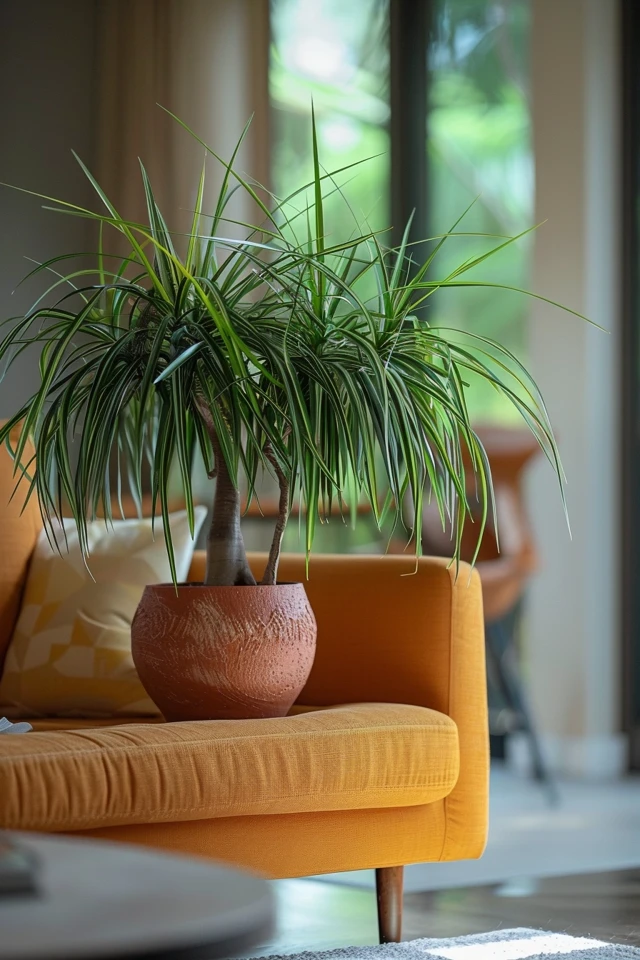Pruning is an essential practice for maintaining the health and promoting the healthy growth of a ponytail palm. Not only does it enhance the plant’s aesthetics, but it also helps in preventing pests and fungal infections. To ensure successful pruning, it’s important to follow the best practices and tips for ponytail palm care.
When it comes to ponytail palm pruning, precision is key. It’s crucial not to over-prune the plant. Instead, focus on removing dead or dying foliage to maintain its natural shape. Regular pruning helps with air circulation and prevents the base of the palm from becoming a breeding ground for pests and diseases.
Key Takeaways:
- Pruning ponytail palms is essential for maintaining their health and promoting healthy growth.
- Prune during the plant’s active growth period in spring or summer.
- Use sharp and clean pruning shears or scissors.
- Remove dead or unattractive foliage close to the trunk to maintain the plant’s rooster-tail shape.
- Regularly inspect and clean the base of the ponytail palm to promote air circulation and prevent pests.

Pruning Techniques for Ponytail Palm
When it comes to maintaining the health and appearance of your ponytail palm, proper pruning techniques are crucial. By following these tips for pruning ponytail palm, you can ensure the plant’s continued growth and vitality.
1. Use the Right Tools
Before you begin pruning your ponytail palm, make sure you have the necessary tools on hand. Sharp, clean pruning shears or scissors are essential for a clean cut. Remember to sterilize your tools to prevent the spread of diseases.
2. Timing is Key
The best time to prune a ponytail palm is during its active growth period in the spring or summer. This is when the plant can quickly recover from the pruning process and promote new growth.
3. Inspect and Remove
Take the time to inspect the leaves of your ponytail palm and remove any that are brown, yellow, or otherwise unattractive. Snip off these unwanted leaves as close to the trunk as possible, maintaining the plant’s rooster-tail shape.

4. Encourage Growth
Pruning not only removes dead or unsightly foliage but also encourages new growth in your ponytail palm. By removing spent leaves and branches, you stimulate the plant’s natural growth processes.
5. Water with Care
After pruning, it’s important to be cautious with watering to prevent root rot. Avoid overwatering the plant and ensure that the soil has time to dry out between waterings. This will help maintain the plant’s overall health and prevent issues from developing.
By following these best practices for ponytail palm pruning, you can keep your plant healthy, vibrant, and visually appealing. Regular grooming and maintenance will reward you with a beautiful ponytail palm that enhances any indoor or outdoor space.
Base Maintenance and Air Circulation for Ponytail Palm
Keeping the base of your ponytail palm clean is essential for maintaining its overall health and promoting healthy air circulation. Regular maintenance of the base helps prevent the buildup of debris and pests, while also ensuring optimal growth and development. Here are some key tips for ponytail palm maintenance, trimming, and grooming:
Inspect and Remove Fallen Leaves
Regularly inspect the base of your ponytail palm for fallen leaves. Gently remove any loose leaves to maintain a clean and tidy base. However, be careful not to tug on leaves that are clinging to the plant, as this can cause damage.
Check for Pests
While cleaning the base, take the opportunity to check for any signs of pests. Look for insects, such as mealybugs or scale, as well as any fungal or bacterial infections. If you notice any issues, take appropriate measures to address them.
Prevent Root Rot
To prevent root rot, it’s crucial to avoid overwatering your ponytail palm. Allow the soil to dry out between waterings, as the plant is more tolerant of underwatering than overwatering. Overwatering can lead to stagnant water in the base, creating an ideal breeding ground for pests and diseases.

Aerate the Soil
Occasionally aerate the soil around the base of your ponytail palm to provide fresh air to the plant’s roots. Gently loosen the soil using a small garden fork or similar tool, being careful not to damage the roots. This simple step helps improve oxygen circulation and promotes healthy root development.
Maintaining a clean and tidy base, checking for pests, preventing root rot, and aerating the soil are all important aspects of ponytail palm maintenance, trimming, and grooming. By following these practices, you can ensure optimal air circulation, prevent the growth of harmful organisms, and promote the overall health and growth of your ponytail palm.
Conclusion
Pruning plays a vital role in the care of a ponytail palm, promoting healthy growth and ensuring its overall well-being. By implementing proper pruning techniques, such as removing dead or damaged foliage and maintaining the plant’s natural shape, you can foster a vibrant and thriving ponytail palm. Remember to perform pruning during the plant’s active growth period in the spring or summer for the best results.
However, pruning is just one aspect of ponytail palm care. Regular maintenance is equally important to support the plant’s health. Keep the base of the palm clean by removing fallen leaves and debris, as this helps promote good air circulation and safeguard against pests and diseases.
In addition to base maintenance, it’s crucial to provide appropriate watering and ensure proper air circulation for the plant. Avoid overwatering, allowing the soil to dry out between waterings, and periodically aerate the soil to provide fresh air to the roots. By considering all of these care practices – pruning, base maintenance, watering, and air circulation – you can foster the healthy growth of your ponytail palm and enjoy its beauty and elegance for years to come.

